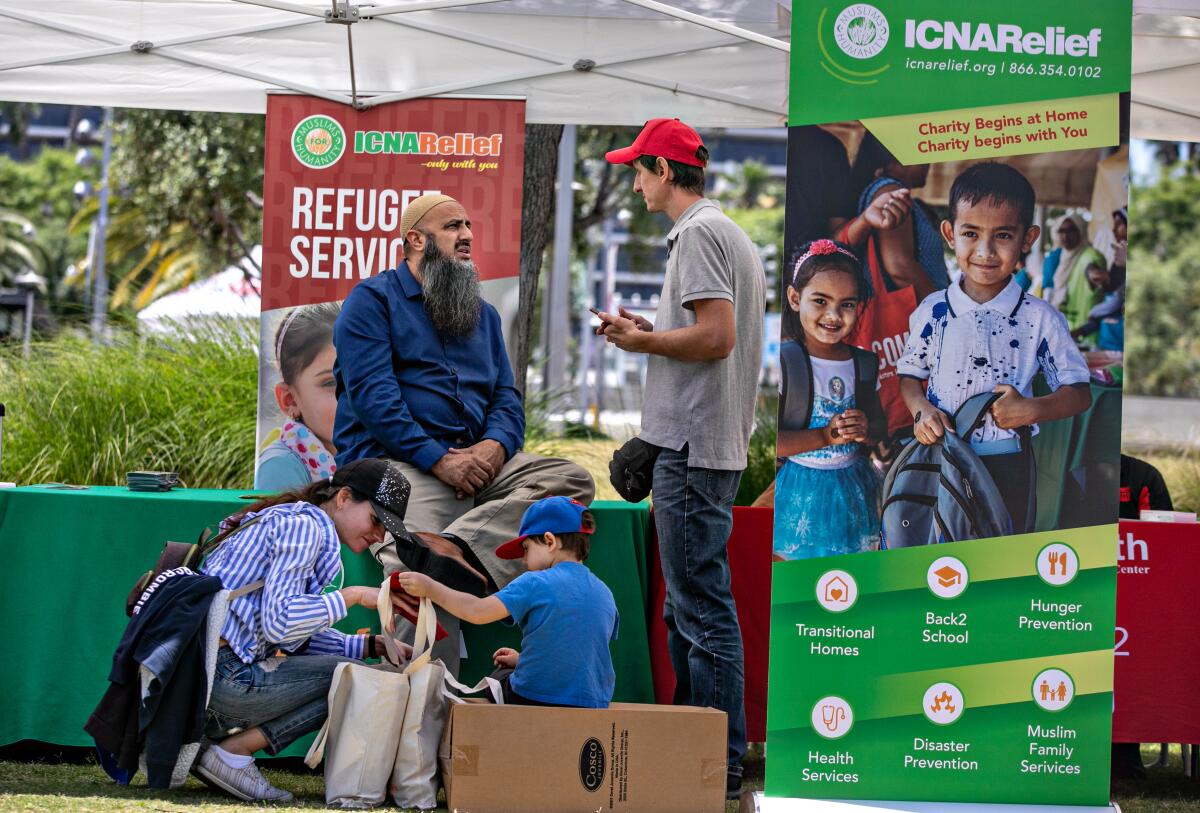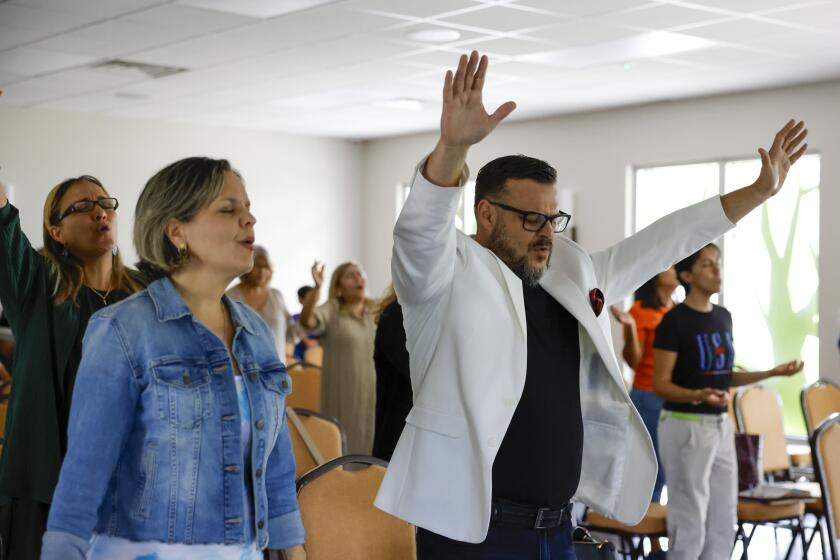Immigrant women are joining the job market at record levels, boosting U.S. employment

- Share via
WASHINGTON — Below the radar of Washington’s highly partisan battles over the U.S.-Mexico border, employment gains for immigrant women in the U.S. are reaching record levels, thanks in part to a surge of Ukrainian refugees.
Many are semi-skilled and highly motivated workers, entering the U.S. legally and through special emergency programs. They are not only easing intense worker shortages in hospitality, retail and other service industries, but are helping drive up employment for the entire country.
People born outside the U.S. make up just 17.5% of the American working-age population, but foreign-born workers 16 years and older accounted for a whopping 64% of the nation’s labor force growth in the two-year period that ended in May, with women making an outsized contribution, according to the Bureau of Labor Statistics.
That compares with a 38% share in the five years to 2019 before the pandemic.
Members of the country’s largest Venezuelan community in Miami have had mixed reactions to Gov. Ron DeSantis’ treatment of immigrants, including his decision to transport migrants to other states.
Migrants from abroad have long been an expanding part of the U.S. labor market, offsetting an aging population and other drags on growth. But their labor participation relative to U.S.-born workers has accelerated further since coming out of the pandemic, thanks to a rebound in normal legal immigration and the arrival of hundreds of thousands of refugees, most notably from Ukraine.
Adding to that are emerging social and economic conditions that are driving more immigrant women to work rather than stay at home.
Statistics now show that the labor participation rate of foreign-born women blew past record levels this year and has nearly caught up with that of U.S.-born women, whose numbers are still below pre-pandemic levels.
“We’re already seeing immigration becoming increasingly important in supporting labor force growth, and it will become even more important,” said Julia Gelatt, a senior analyst at the nonpartisan Migration Policy Institute.
Beyond filling employers’ immediate needs, these newcomers are expected to provide a critical cushion to a U.S. workforce hit by both short-term and longer-running forces: retirements and a surge in workers quitting jobs post-pandemic; declining birthrates; and rising deaths, including drug-related fatalities, suicides and other so-called deaths of despair.
Since Russia’s invasion of Ukraine last year, some 300,000 people from that war-torn country have arrived in the U.S., many under the Biden administration’s “Uniting for Ukraine” program. About 100,000 Afghans have come since the fall of Kabul in the late summer of 2021, and tens of thousands more from Venezuela and Cuba, among other countries, are being admitted for humanitarian reasons.
Individuals entering under urgent refugee and parole programs can secure work permits relatively quickly. They can generally stay for at least two years. Some have come with university degrees and needed skills like nursing. Others are eagerly filling lower-paying openings at restaurants, hotels, retail stores and nursing homes — jobs that U.S. citizens are largely passing up.
Vita Bohera and Nadia Senkiv are from the Lviv region in western Ukraine. Sponsored by relatives in the U.S., the two distant cousins landed in Portland, Ore., at the end of August. By November, Bohera and Senkiv, who are both in their 30s, got work authorization papers.
“I was just sitting at home thinking, ‘What am I going to do in this country?’” said Bohera, a university graduate who worked as an English teacher in Ukraine. She began browsing Facebook pages for job opportunities. After two months of training, Bohera found work as a medical interpreter, earning $20 to $40 an hour. Sometimes she drives long distances for appointments. “The company usually pays for mileage, which is great,” she said.
Bohera came with her two children, ages 12 and 16, but not her husband. Most men in Ukraine are held back because of the potential call for military service.
Senkiv, 31, does not have children but also left her husband in Ukraine and is staying with her younger brother, who has been in the U.S. for several years. Her path to employment was different. In her hometown of Drohobych, Senkiv attended vocational school after completing basic ninth-grade education. She worked for a company preparing dumplings and other ready-made foods.
In Portland, she learned of a job opening from a woman attending the same Ukrainian church. Since March, Senkiv has been working as a full-time cook at a preschool in southeast Portland. She also has a second job, putting in two hours at night clearing tables and washing dishes at a senior living center for $14.75 an hour.
Senkiv doesn’t make a lot more at the preschool, and she’s quickly learned of a common American irritant: “My salary is OK, but taxes are high.” Still, Senkiv says she is happy with her job — she loves working with kids. “The children like to hug. We don’t hug so much in Ukraine,” she said, her words translated by her cousin.
How do citizens of Kyiv cope with the sleep deprivation and stress from Russia’s war on Ukraine? Some push it down, some try yoga or dancing.
Working in the kitchen or at a senior facility are among many service jobs that have gone begging, especially since the country has come out of the pandemic.
Even amid modest economic growth, there were more than 10 million openings in the U.S. this spring — almost two jobs for every officially unemployed person, according to the latest government figures.
Job vacancies were up more than 50% in healthcare and social assistance establishments compared with 2019 before the pandemic, and they were up 22% at lodging and food service businesses, where turnover is rampant. Rough estimates indicate that as many as 50,000 positions that include dishwashing duties may be available, based on job listings in Indeed.
Immigrants make up an especially big part of the workforce at hotels and restaurants. Marriott International says it has hired more than 550 refugees in the U.S. since last year. It is one of a dozen companies in lodging, manufacturing, cleaning and other services that have pledged to hire 20,000 refugees over three years.
“We’re in a unique moment, politically and economically,” said Yaron Schwartz, the U.S. director for Tent Partnership for Refugees, a nonprofit mobilizing companies to hire and train refugees.
There are other reasons for the rise in labor participation among immigrant women. Like women overall, those foreign-born are increasingly better educated, which means they’re more likely to be working.
Economic pressures also are pushing traditional immigrant households to put stay-at-home moms into outside work, especially given the last couple of years of high inflation.
“It’s almost a necessity,” said Naomi Cruz, a Glendale immigration attorney who had been the L.A. lead at the Latinista, a group promoting careers and entrepreneurs among Latinas.
Nearly one-third of Latinos in the U.S. are foreign-born. In more recent years Asia has been the leading source of immigrants, and among women, Census Bureau statistics show that those from India have seen the biggest employment gains, likely reflecting more spouses of tech workers with H-1B visas in the job market.
Overall, net immigration to the U.S., including refugees, exceeded 1 million between 2021 and 2022. That was more than double the number in each of the prior two years, when the pandemic and other border-tightening policies under the Trump administration brought international migration to a decades low.
Experts don’t expect such big increases in immigration in the years ahead because of caps under U.S. law, but various humanitarian programs allowing up to 30,000 people a month from Venezuela, Cuba, Haiti and Nicaragua are likely to continue to boost the numbers.
These and others from abroad are expected to become increasingly important for the labor force as the U.S. joins other advanced economies caught in a demographic squeeze.
Especially for states like California, international migration is the difference between a growing or shrinking population, especially as many appear to be moving out of the state because of its high living costs.
Just how many of the refugees will reside in the U.S. and work beyond two years is unknown. Viktoriia Gorbachevska, 29, who quickly found work as a business analyst in Raleigh, N.C., since arriving from Ukraine in November after getting matched with a sponsor through Welcome Connect, isn’t sure. But she sees a lot of potential to build a future in the U.S.
“This country is good for educated young people starting work here,” said Gorbachevska, who has a master’s degree and is married with two young children.
The Biden administration has already created a pathway for Afghan nationals to extend their stay, and many refugees in general are expected to seek permanent status through asylum and other programs.
Zakira, who asked that her last name not be used because of security concerns, fled Kabul on Aug. 19, 2021, just four days after the Taliban captured the capital city.
“That day was hard for me,” Zakira said as she recalled working at a hospital as panic swept her family. “My dad called me. ‘Where are you? Why are you at work?’”
Zakira, 26, and her 17-year-old sister first arrived in Qatar, then found transport to Washington, D.C. And after two months at a base in Texas, the two sisters settled in Portland.
Zakira was a nurse in Afghanistan, and she initially found employment at a nursing home. Then at the end of last year, she left for a better-paying job at a hospital caring for patients. She is now getting training in phlebotomy. Her sister is attending high school, and the two live in a one-bedroom apartment in downtown Portland.
In Kabul, they left behind their parents, as well as a brother and older sister married with children. Zakira said she fled because she wanted to get away from a regime that “ended the dreams” for girls and women wanting to go to school or pursue a career.
“It’s good,” she said of opportunities in the U.S. “We can study, we can work. But it’s hard for me,” she added. “I have a plan, but without my family it’s hard. I don’t know. It’s hard for me.”
Zakira said she will apply for asylum.
More to Read
Get the L.A. Times Politics newsletter
Deeply reported insights into legislation, politics and policy from Sacramento, Washington and beyond. In your inbox three times per week.
You may occasionally receive promotional content from the Los Angeles Times.













